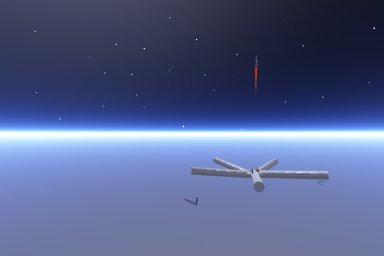|
Near
Space
Near
Space
Developing
the Shore to Our New Ocean

Copyright
- JPAerospace
JP Aerospace's Stratostation
concept for a "manned sub-orbital space station.
Floating at 140,000 feet this structure will serve as a launch
platform, research facility
and tourism destination. At over a mile across, it will be
supported by multiple Helium lift cells."
For those who want to go to space to explore
the Moon and Mars and to develop human settlements, the transition
region between earth and space may seem a dull byway off the
road to orbit.
But perhaps it is time to see our high altitude
realm in a new way. Rather than as an area merely to pass
through, we should view Near
Space as the shore line where we develop and perfect
our ships and techniques for the deep sea voyages.
Like a sea shore, Near Space offers numerous
features that allow for recreational and practical activities.
The new Near
Space section discusses the activities that
are going on in the region of 25km to 200km. Balloons
can reach about half-way into this region and sub-orbital
rockets can traverse the entire domain and beyond.
Such vehicles are referred to as nearcraft.
Near Space
offers cheap and quick access to
spacelike conditions as compared to getting a launch to orbit.
For a few hundred dollars a high altitude balloon can take
a payload to 30km or so.
Because of the low cost,
amateur groups are participating in more and more
activities in Near Space. Ham radio enthusiasts, students,
and amateur scientists carry out high altitude experiments
in astronomy and atmospheric studies, take high altitude pictures,
and test equipment that will be used on satellites.
As discussed in the article Sub-orbital
Rockets to Space: The Next Logical Step?, developing
sub-orbital RLVs by small private companies
will be much quicker and cheaper than developing orbital vehicles.
The technology and operations techniques developed from experience
with sub-orbital systems will then be applicable to second
generation vehicles intended for orbit.
The payoff for these vehicles will come not
just from taking over the current sounding
rocket market, but also from creating new markets
as well. For example, a high altitude
camera on an RLV can see for several hundred miles
farther than with aerial photography and access to a given
area is more flexible than via the infrequent flyovers of
remote sensing satellites. (Balloons can also be used but
they are limited by winds and other weather conditions.)
The most exciting new market is
sub-orbital space tourism. Though such
trips may last only half an hour or so, at the
top of 100km trajectory you will see the curvature of the
earth below and a dark starry sky above. And you will experience
the accelerating thrill of riding a rocket and a few minutes
of microgravity.
Although expensive (at least $100k), many
people may actually prefer this kind of brief initial space
experience over a full blown stay in orbit for several days.
See the Sub-orbital
Space Tourism section.
There are also advanced
concepts such as manned platforms at high altitudes
and parachuting from high altitudes as the ultimate
extreme sport.
The Near
Space section will monitor developments in
this exciting realm. Visit often!
|


